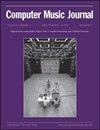Jack Callahan and Jeff Witscher: Stockhausen Syndrome
IF 0.4
Q4 COMPUTER SCIENCE, INTERDISCIPLINARY APPLICATIONS
引用次数: 0
Abstract
gins in a thumb piano improvisation by Durrant. Initially, Cundy had collaborated remotely with Durrant during the United Kingdom’s first Covid lockdown in 2020. This track also demonstrates Cundy’s approach to compositional reworking, resulting in what Cundy calls “a map or an abstraction of a remote landscape in which contour lines and place names have been taken away.” In this case, the thumb piano sound class has been completely masked, rendering the source unrecognizable. “First Attempt” (track 3) begins with the breath, producing a convincing starting point. Here, Cundy produces static textures similar to the ones heard in “Circular Attempt.” But this track demonstrates a more obvious use of flute and clarinet timbres, in contrast to other highlighted breath sounds. One hears a slow counterpoint between the individual sustaining lines as well, suggesting a process of stretching material horizontally. Compositional techniques like these could be characterized as Cundy’s attempts to expose the listener to varying perspectives and positions of a given sound mass. The final track, “Undoing,” suggests a collapse of one’s sound materials, demonstrating a way Cundy reflects on the previous pieces heard in this set. I also consider this track as a way that the composer galvanizes Crude Attempt. The same compositional devices heard in the previous tracks have been used, except in this track, Cundy manages to form an emergent other voice, which slowly projects outward. Ultimately, I view this track as another example of Cundy reworking his materials, leading him to develop yet another approach to shaping his sound materials. Cundy has discussed with me his stance on the issue of reworking material. He mentioned that, overall, he is “interested in how an artistic practice absorbs a language of sounds, accumulates vocabularies from various places, and how the individual sets about reworking these disparate strands in the present.” For Cundy, an example of this way of working stems from his experience recording “Mountains” (1977) for solo bass clarinet and magnetic tape by Dutch composer Ton de Leeuw. While recording this work, Cundy realized de Leeuw’s approach to working with North Indian traditional music without reproducing imitations of this tradition. Another influence related to Cundy’s developing vocabulary in Crude Attempt is the classic text New Sounds for Woodwind (originally published in 1967), written by Bruno Bartolozzi. This book served as a way to assist woodwind instrumentalists in order to adapt their microtonal playing when performing with the developing electronic sounds of the time—allowing electronic source material to perhaps affect musical decisions of conventional acoustic instrumentalists. This concept, wherein electronics influence one’s performance, is evidenced in Cundy’s home-studio approach. In a broader sense, one could view Cundy’s compositional approach as similar to Natalie Jeremijenko’s view of design, as well. She views all making as remaking, due to its generative and re-generative nature. For example, in Crude Attempt, Cundy successfully adapts aspects of his physical environment and his instruments (conventional and electronic), suggesting a self-reflexive process. As Cundy engages with his own work, he continues to integrate concepts of others, as well as reevaluate aspects of his previous practices. It is in the results of this process of critical evaluation that Cundy has formed his own distinctive sonic practice in Crude Attempt.Jack Callahan和Jeff Witscher:斯托克豪森综合征
达兰特即兴演奏的拇指钢琴中的杜松子酒。最初,康迪在2020年英国首次新冠肺炎封锁期间与达兰特进行了远程合作。这首曲目还展示了康迪的作曲方法,产生了康迪所说的“一幅地图或一个偏远景观的抽象,其中的轮廓线和地名被删除了。”在这种情况下,拇指钢琴声音类被完全掩盖,使音源无法识别。“第一次尝试”(曲目3)以呼吸开始,产生了一个令人信服的起点。在这里,Cundy产生了类似于“Circular Attempt”中听到的静态纹理。但与其他突出的呼吸声相比,这首曲目展示了长笛和单簧管音色的更明显使用。人们还可以听到单个支撑线之间的缓慢对位,这表明材料是水平拉伸的过程。像这样的作曲技巧可以被描述为康迪试图让听众接触到给定声量的不同视角和位置。最后一首曲目《Undoing》暗示了一个人的声音材料的崩溃,展示了康迪对这套作品中听到的前几首作品的反思方式。我也认为这首歌是作曲家激发《粗鲁的尝试》的一种方式。使用了与前几首曲目中相同的作曲装置,只是在这首曲目中,Cundy设法形成了一种突现的另一种声音,这种声音慢慢向外突出。最终,我将这首歌视为康迪重新创作素材的又一个例子,使他开发了另一种塑造声音素材的方法。Cundy已经和我讨论了他在返工材料问题上的立场。他提到,总的来说,他“感兴趣的是艺术实践如何吸收一种声音语言,积累来自不同地方的词汇,以及个人如何在当下着手重新创作这些不同的线索。”对于Cundy来说,这种工作方式的一个例子源于他为荷兰作曲家Ton de Leeuw的独奏低音单簧管和磁带录制《山脉》(1977)的经历。在录制这首作品时,Cundy意识到了de Leeuw在不复制这一传统的情况下与北印度传统音乐合作的方法。与Cundy在《粗鲁的尝试》中发展词汇有关的另一个影响是Bruno Bartolozzi撰写的经典文本《Woodwind的新声音》(最初出版于1967年)。这本书为木管乐器演奏家提供了一种帮助,使他们在与当时发展中的电子声音进行表演时能够调整他们的微音调演奏——这使得电子源材料可能会影响传统声学乐器演奏家的音乐决策。这一概念,其中电子产品影响一个人的表现,证明了康迪的家庭工作室方法。从更广泛的意义上讲,人们也可以将Cundy的构图方法视为与Natalie Jeremijenko的设计观相似。她认为所有的制作都是重新制作,因为它具有生成性和再生成性。例如,在《粗鲁的尝试》中,康迪成功地适应了他的物理环境和仪器(传统和电子),这表明了一个自我反射的过程。当Cundy从事自己的工作时,他继续整合他人的概念,并重新评估他以前的实践。正是在这个批判性评价过程的结果中,康迪在《粗试》中形成了自己独特的声音实践。
本文章由计算机程序翻译,如有差异,请以英文原文为准。
求助全文
约1分钟内获得全文
求助全文
来源期刊

Computer Music Journal
工程技术-计算机:跨学科应用
CiteScore
1.80
自引率
0.00%
发文量
2
审稿时长
>12 weeks
期刊介绍:
Computer Music Journal is published quarterly with an annual sound and video anthology containing curated music¹. For four decades, it has been the leading publication about computer music, concentrating fully on digital sound technology and all musical applications of computers. This makes it an essential resource for musicians, composers, scientists, engineers, computer enthusiasts, and anyone exploring the wonders of computer-generated sound.
Edited by experts in the field and featuring an international advisory board of eminent computer musicians, issues typically include:
In-depth articles on cutting-edge research and developments in technology, methods, and aesthetics of computer music
Reports on products of interest, such as new audio and MIDI software and hardware
Interviews with leading composers of computer music
Announcements of and reports on conferences and courses in the United States and abroad
Publication, event, and recording reviews
Tutorials, letters, and editorials
Numerous graphics, photographs, scores, algorithms, and other illustrations.
 求助内容:
求助内容: 应助结果提醒方式:
应助结果提醒方式:


